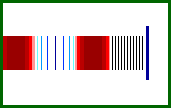Sound Waves and the Eardrum
A sound wave traveling through a fluid medium (such as a liquid or a gaseous material) has a longitudinal nature. This means that the particles of the medium vibrate in direction which is parallel (and anti-parallel) to the direction which the sound wave travels. If the sound wave travels from west to east, then the particles of the medium vibrate back and forth along the east-west axis. As a sound wave impinges upon a particle of air, that particle is temporarily disturbed from its rest position. This particle in turn pushes upon its nearest neighbor, causing it to be displaced from its rest position. The displacement of several nearby particles produces a region of space in which several particles are compressed together. Such a region is known as a compression or high pressure region. A restoring force typically pulls each particle back towards its original rest position. As the particles are pulled away from each other, a region is created in which the particles are spread apart. Such a region is known as a rarefaction or low pressure region. Because a sound wave consists of an alternating pattern of high pressure (compressions) and low pressure (rarefactions) regions traveling through the medium, it is known as a pressure wave.
When a pressure wave reaches the ear, a series of high and low pressure regions impinge upon the eardrum. The arrival of a compression or high pressure region pushes the eardrum inward; the arrival of a low pressure regions serves to pull the eardrum outward. The continuous arrival of high and low pressure regions sets the eardrum into vibrational motion. This is depicted in the animation below.

The eardrum is attached to the bones of the middle ear - the hammer, anvil, and stirrup. As these bones begin vibrating, the sound signal is transformed from a pressure wave traveling through air to the mechanical vibrations of the bone structure of the middle ear. These vibrations are then transmitted to the fluid of the inner ear where they are converted to electrical nerve impulses which are sent to the brain.
Since the eardrum is set into vibration by the incoming pressure wave, the vibrations occur at the same frequency as the pressure wave. If the incoming compressions and rarefactions arrive more frequently, then the eardrum vibrates more frequently. This frequency is transmitted through the middle and inner ear and provides the perception of pitch. Higher frequency vibrations are perceived as higher pitch sounds and lower frequency vibrations are perceived as lower pitch sounds.
The intensity of the incoming sound wave can also be transmitted through the middle ear to the inner ear and interpreted by the brain. A high intensity sound wave is characterized by vibrations of air particles with a high amplitude. When these high amplitude vibrations impinge upon the eardrum, they produce a very forceful displacement of the eardrum from its rest position. This high intensity sound wave causes a large vibration of the eardrum and subsequently a large and forceful vibration of the bones of the middle ear. This high amplitude vibration is transmitted to the fluid of the inner ear and encoded in the nerve signal which is sent to the brain. A high intensity sound is perceived as a relatively loud sound by the brain.
For more information on physical descriptions of waves, visit The Physics Classroom Tutorial. Detailed information is available there on the following topics:
Mechanical Wave
Longitudinal Wave
Pressure Wave
The Human Ear
Pitch and Frequency
Intensity/Decibel Scale